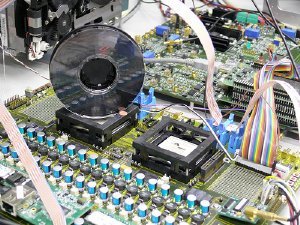Jan 22 2010
IBM researchers today announced they have demonstrated a world record in areal data density on linear magnetic tape - a significant update to one of the computer industry's most resilient, reliable and affordable data storage technologies.
 IBM demonstrates new record in magnetic tape data density.
IBM demonstrates new record in magnetic tape data density.
This breakthrough proves that tape technology can increase capacity for years to come, which has important implications, as tape storage systems are more energy efficient and cost-effective than hard disk drive storage systems. Businesses and governments use magnetic tape to store, protect and access large volumes of important data, including: data and video archives, back-up files, replicas for disaster recovery, and retention of information required for regulatory compliance.
The scientists at IBM Research - Zurich, in cooperation with the FUJIFILM Corporation of Japan, recorded data onto an advanced prototype tape, at a density of 29.5 billion bits per square inch - about 39 times the areal data density of today's most popular industry-standard magnetic tape product. To achieve this feat, IBM Research has developed several new critical technologies, and for the past three years worked closely with FUJIFILM to optimize its next-generation dual-coat magnetic tape based on barium ferrite (BaFe) particles.
"This exciting achievement shows that tape storage is alive and strong and will continue to provide users reliable data protection, while maintaining a cost advantage over other storage technologies, including hard disk drives and flash," said Cindy Grossman, vice president, IBM Tape and Archive Storage Systems.
"This tape storage density demonstration represents a step towards developing technologies to achieve tape areal recording densities of 100 billion bits per square inch and beyond. Such technologies will be necessary to keep up with the rapid increase in digital information. IBM is in the unique position to help clients store, maintain and analyze the wealth of data accumulating, and thus help them achieve efficiencies and advantages in the way they do business," comments Evangelos Eleftheriou, IBM Fellow.
Critical business data is often contained in automated tape libraries, where one or more tape drives service dozens to thousands of tape cartridges. High-end tape libraries can store petabytes - millions of gigabytes - of information. On a per-gigabyte basis, tape systems currently cost about one-fifth to one-tenth of a hard disk drive (HDD) storage systems, depending on the size. Also, tape is by far one of the most energy-efficient storage technology available today because tape cartridges only consume energy when being accessed unlike disks, which spin continuously.
For the past several years, scientists from IBM Research - Zurich have dramatically improved the precision of controlling the position of the read-write heads, leading to a more than 25-fold increase in the number of tracks that can be squeezed onto the half-inch-wide tape. In addition, they have developed new advanced detection methods to improve the accuracy of reading the tiny magnetic bits, thereby achieving an increase in the linear recording density of more than 50 percent. Another key enabling technology for achieving the required track-follow performance in this demonstration was a new, low-friction read-write head developed by IBM Research - Almaden, which has also been collaborating with FUJIFILM to develop next-generation media.
IBM has a long history of innovation in magnetic-tape data storage. Its first commercial tape product, the 726 Magnetic Tape Unit, was announced nearly 60 years ago. It used reels of half-inch-wide tape that each had a capacity of about 2 megabytes. The areal density demonstration announced today represents a potential increase in capacity of 17,500,000 times compared with IBM's first tape drive product. This announcement reaffirms IBM's continued commitment and leadership in magnetic tape technology.
As the planet becomes more intelligent, integrated and interconnected, there will be an explosive growth in the rate at which data is created. The majority of this data, such as transportation traffic patterns, the food supply chain, image rich media, and health and financial industries, will be stored on tape.
Technical details: IBM's world-record achievement leverages notable improvements in four areas of the magnetic tape system
-
New high-density, dual-coated particulate magnetic tape: Developed by FUJIFILM Corporation in Japan in close collaboration with IBM Research scientists, this next-generation version of its NANOCUBIC(TM) tape uses a new ultra-fine, perpendicularly-oriented barium-ferrite magnetic medium that enables high-density data recording without using expensive metal sputtering or evaporation coating methods.
-
Advanced servo control technologies for ultra accurate head positioning: Three new servo control technologies have been developed by IBM Research - Zurich, leading to a more than 25-fold increase in the number of data tracks that can be squeezed onto the half-inch-wide tape:
-
a new servo pattern, enabling the generation of high-bandwidth nanometer-scale position information; a new method for detecting and decoding the position information encoded in the servo pattern, and advanced state-space-based control concepts that, combined with the other two technologies, culminated in the demonstration of an extremely precise track-follow performance of less than 24 nm standard deviation from the target track position. These technologies were instrumental in reducing the track width to less than 0.45 micrometers.
-
Innovative signal-processing algorithms for the data channel: An advanced data read channel based on a new data-dependent noise-predictive, maximum-likelihood (DD-NPML) detection scheme was developed at IBM Research - Zurich to enable the accurate detection of the data despite the reduction in the signal-to-noise ratio resulting from the use of an ultra-narrow 0.2-µm data reader head. With this technique, which also takes the noise characteristics of FUJIFILM's BaFe medium into account, a linear density increase of more than 50 percent relative to LTO Generation 4 was achieved.
-
Low-friction GMR (giant magnetoresistive) read/write head assemblies: Two new head technologies have been developed by the tape development and research teams at IBM Research - Almaden, namely, a new reduced-friction head assembly that allows the use of smoother magnetic tapes and an advanced GMR head module incorporating optimized servo readers. These head technologies were critical for achieving the required track-follow performance mentioned above.